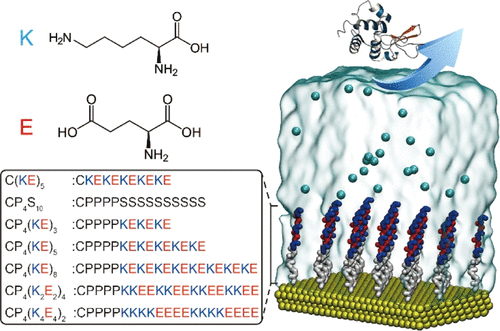当前位置:
X-MOL 学术
›
Biomacromolecules
›
论文详情
Our official English website, www.x-mol.net, welcomes your
feedback! (Note: you will need to create a separate account there.)
Structures and Antifouling Properties of Self-Assembled Zwitterionic Peptide Monolayers: Effects of Peptide Charge Distributions and Divalent Cations.
Biomacromolecules ( IF 5.5 ) Pub Date : 2020-04-08 , DOI: 10.1021/acs.biomac.0c00062 Chuanxi Li 1, 2, 3 , Chunjiang Liu 1 , Minglun Li 2 , Xin Xu 2 , Shuzhou Li 2 , Wei Qi 1, 3 , Rongxin Su 1, 3 , Jing Yu 2
Biomacromolecules ( IF 5.5 ) Pub Date : 2020-04-08 , DOI: 10.1021/acs.biomac.0c00062 Chuanxi Li 1, 2, 3 , Chunjiang Liu 1 , Minglun Li 2 , Xin Xu 2 , Shuzhou Li 2 , Wei Qi 1, 3 , Rongxin Su 1, 3 , Jing Yu 2
Affiliation

|
Zwitterionic peptides are great candidates as antifouling coating materials in many biomedical applications. We investigated the structure and antifouling properties of surface-tethered zwitterionic peptide monolayers with different peptide chain lengths and charge distributions using a combination of surface plasma resonance, atomic force microscopy, and all atomistic molecular dynamics (MD) simulation techniques. Our results demonstrate that zwitterionic peptides with more zwitterionic lysine (K) and glutamic acid (E) repeating units exhibit better antifouling performance. The block charge distributions of the positive and negative charges in the peptides (having multiple positive charges next to the same amount of negative charges), although affecting the structure of the peptide molecules, do not significantly change the antifouling properties of the peptide monolayers in the solutions containing monovalent ions. However, divalent cations, Ca2+ and Mg2+, in solution can significantly alter the structure and lower the antifouling performance of the zwitterionic peptide monolayers, especially with the sequences of block charges. All atomistic MD simulations quantitatively reveal that the divalent cations in solution lead to more interchain electrostatic cross-links between peptide chains, especially for peptides with block charges, which causes dehydration of the zwitterionic peptides and diminishes their antifouling performances.
中文翻译:

自组装的两性离子肽单分子膜的结构和防污性能:肽电荷分布和二价阳离子的影响。
两性离子肽在许多生物医学应用中作为防污涂料的理想选择。我们结合表面等离子体共振,原子力显微镜和所有原子分子动力学(MD)模拟技术,研究了具有不同肽链长度和电荷分布的表面束缚的两性离子肽单层的结构和防污性能。我们的结果表明,具有更多两性离子赖氨酸(K)和谷氨酸(E)重复单元的两性离子肽表现出更好的防污性能。尽管会影响肽分子的结构,但肽中正电荷和负电荷的嵌段电荷分布(在相同数量的负电荷旁边具有多个正电荷)不会明显改变含单价离子溶液中肽单层的防污性能。但是,二价阳离子溶液中的2+和Mg 2+会显着改变两性离子肽单分子层的结构并降低其防污性能,尤其是在带有嵌段电荷的序列中。所有原子MD模拟都定量显示溶液中的二价阳离子导致肽链之间的链间静电交联更多,尤其是对于带有嵌段电荷的肽而言,这会导致两性离子肽脱水并降低其防污性能。
更新日期:2020-04-08
中文翻译:

自组装的两性离子肽单分子膜的结构和防污性能:肽电荷分布和二价阳离子的影响。
两性离子肽在许多生物医学应用中作为防污涂料的理想选择。我们结合表面等离子体共振,原子力显微镜和所有原子分子动力学(MD)模拟技术,研究了具有不同肽链长度和电荷分布的表面束缚的两性离子肽单层的结构和防污性能。我们的结果表明,具有更多两性离子赖氨酸(K)和谷氨酸(E)重复单元的两性离子肽表现出更好的防污性能。尽管会影响肽分子的结构,但肽中正电荷和负电荷的嵌段电荷分布(在相同数量的负电荷旁边具有多个正电荷)不会明显改变含单价离子溶液中肽单层的防污性能。但是,二价阳离子溶液中的2+和Mg 2+会显着改变两性离子肽单分子层的结构并降低其防污性能,尤其是在带有嵌段电荷的序列中。所有原子MD模拟都定量显示溶液中的二价阳离子导致肽链之间的链间静电交联更多,尤其是对于带有嵌段电荷的肽而言,这会导致两性离子肽脱水并降低其防污性能。











































 京公网安备 11010802027423号
京公网安备 11010802027423号